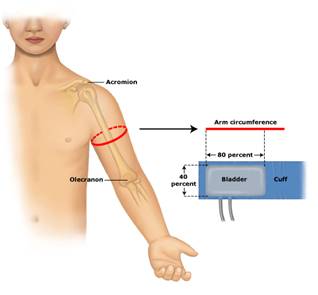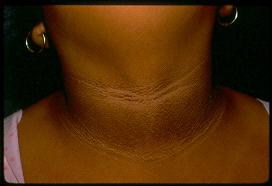Physical exam
BMI
- This should be performed at least once a year.
- Get an accurate height!
- Most primary obesity results in elevated height and weight while secondary causes of obesity often manifest as a child who is short for age with elevated weight.
- Compare to previous values and plot on a growth curve.
Blood pressure (Fourth Report, 2004; Matoo, 2009)
Have the patient sit down for 5 minutes and remain calm if possible.
Use an appropriate sized cuff. Appropriate cuff size = inflatable bladder width at least 40% of the arm circumference at a point midway between the olecranon and the acromion. Cuff bladder length should cover 80-100% of the circumference of the arm. Bladder width-to-length ratio should be at least 1:2
- Systolic blood pressure is determined by the onset of Korotkoff sounds
- Diastolic blood pressure is determined by the disappearance of Korotkoff sounds
Auscultation is the recommended method of obtaining blood pressure. Exceptions include newborn and young infants or those in an intensive care setting who need frequent blood pressure readings. If automatic devices are used, they must be routinely and accurately calibrated and all elevated readings should be confirmed by auscultation.

Fundoscopic exam
Thyroid exam
Sexual maturity rating
Skin exam
- Looking for abdominal striae or acanthosis nigricans

Abdominal exam
A thorough abdominal exam is necessary to screen for non-alcoholic steatohepatitis (NASH) or non-alcoholic fatty liver disease (NAFLD), which are comorbidities of obesity
- Most of the time there will be no signs or symptoms for either disorder
- Feel for hepatomegaly
- Patients may complain of fatigue or right upper quadrant pain
- Very rarely, patients have signs of liver disease
- Slipped capital femoral epiphysis (SCFE) (Kienstra, 2009)
- Palmar erythema
- Spider angiomata
- Muscle wasting
- Jaundice
- Encephalopathy
Orthopedic evaluation
- Slipped capital femoral epiphysis (SCFE) (Kienstra, 2009)
- Patients may have an altered gait - the foot on the affected side turns out more than the unaffected side.
- Patients take short steps on the affected side to minimize weight bearing.
- They may shift the torso over the affected side.
- With bilateral SCFE, patients may exhibit a waddling gait.
- There may be atrophy of the upper thigh and gluteal muscle.
- There will be pain over the anterior hip without knee pain. There may be decreased range of motion with internal rotation, abduction and flexion through the affected side.
- Tibia Vara (Klish, 2009). Patients may have progressive bowing of the legs. This may be accompanied by tibial torsion.